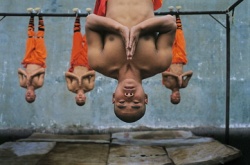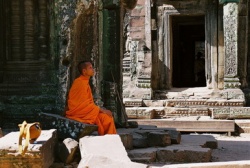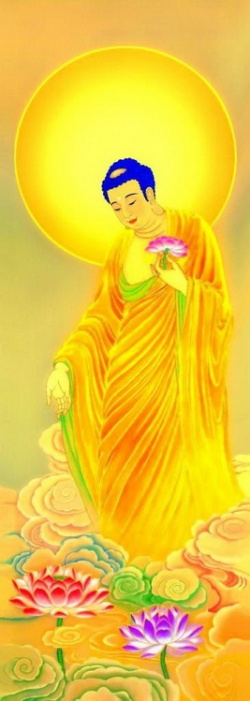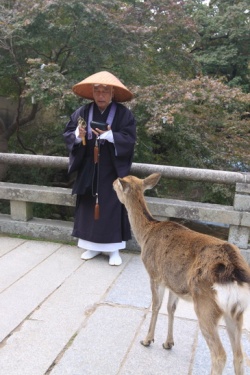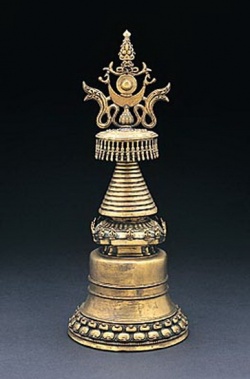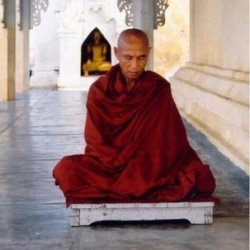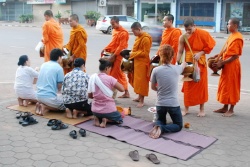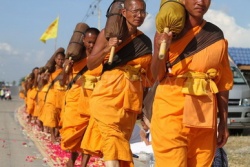A Brief Historical Background of the Religious Institutions of Bhutan
by Dasho Rigzin Dorje
LAND:
Bhutan is a small Himalayan Kingdom bordered by India on the south and by the Tibetan Autonomous Region of China on the north and north west. It comprises land area of 46,500 square kilometers and has a population of 1.3 million. The land lies between latitudes 26 degree 46 N and 28 degrees 10 N and between longitudes 88 degrees 45 E and 92 degrees 10 E. The country has a maximum latitudinal distance of 170 kilometers and a maximum longitudinal distance of 300 kilometers.
The lofty and rugged mountain ranges rendered very difficult and Form of communication between one valley and the other. It may be said that the eighteen districts that comprise present-day Bhutan evolved from the history and traditions of The country with the population settled in secluded fertile valleys surrounded and sheltered by the great Himalayan peaks. Living in these isolated valleys which were linked physically to one another only by high mountain passes, the Bhutanese people developed their own customs, traditions and folklore which remained practically untouched over the centuries.
HISTORY:
As a result of the rugged inaccessibility of The country and its policy of self-imposed isolation. Bhutan may be the only nation in the World that has remained a sovereign independent country throughout its recorded history which goes back to the 7th century A D. Though small in size and population Bhutan has always taken pride in its unique national identity and rich cultural and religious heritage. The history of Bhutan is closely linked with the spread of Buddhism in the Himalayas.
Buddhist has always played an important role in the history of The country and in the way of Life of its people. The growth of Buddhism in Bhutan was first advanced by the great Uddiyana saint Padmasambhava in the 8th century A. D. He thus laid the foundation of one of the most important and unifying forces that has sustained the Bhutanese people and contributed to the Evolution of their unique cultural and religious tradition.
From the 9th Century onwards, many Enlightened religious personages played varied roles in the lives of the Bhutanese people and the growth of their distinctive national identity. The numerous famous religious figures have left their marks influenced The History of Buddhism in Bhutan upto the beginning of the 17th century which cannot all be described within the scope of this article. Bhutanese Buddhism derives much from the genius of the following persons, all of whom are unanimously acclaimed as the Spiritual ancestors of the Nyingmapa (Old School) and Drukpa Kargyupa (New School) schools: BGuru Padmasambhava, Longchen Rabjampa,. Phajo Drukgom Zhigpo, Dorji Lingpa, Choejhi Kunga Paljor, Padma Lingpa, Drukpa Kunlay, Yongdzin Ngagiu Wanmgchu and Mipham Tenpai Nyima. However, no one has had a greater impact on the history of Budhdism in Bhutan than Zhabdrung Ngawang Namgyel (1594-1651 A.D), popularly known as Zhabdrung Rinpoche, of the Drukpa Kargyupa School.
ZHABDRUNG NGAWANG NAMGYEL
Zhabdrung Rinpoche meaning "the precious jewel at whose feet on submits", as he is reverently referred to, was not only a great Spiritual personality but also a statesman and leader of exceptional ability. He not only successfully crushed several foreign invasions, but in the process, being a great architect and builder, set up a chain of sturdy Monastery fortresses called dzongs which became the centers of religious and civil authority. He brought peace, security and stability to The country by establishing a strong and dynamic administrative system and by codifying a set of strict but fair and just laws of such enduring values based on the Buddhist tradition that they have formed the framework for the present judicial system of Bhutan. He promulgated the Dharma and perpetuated the Buddhist order by establishing The Sangha community which to this day plays a very important role in The country. Indeed, the traditions. customs and culture of present-day Bhutan all carry the mark and influence of Zhabdrung Rinpoche who is truly considered by all the people to be the founder and father of the Bhutanese nation.
The Dual system of administration which Zhabduring Ngawang Nsamgyel established, whereby a Spiritual leader looked after the clergy and a temporal ruler looked after the affairs of the state, endured till the establishment of hereditary monarchy in 1907.
Although numerous scholar-saints and sages of different traditions of Buddhism appeared in Bhutan from the 9th to the 16th centuries A.D. and established many Monasteries throughout The country, the first Sangha was instituted by Zhabdrung Rinpoche with only 30monks in 1620 A.D. when the completed the first monastic centre at Chari dorjidan about 14 kilometres north of Thimphu, the present capital of Bhutan, under the chief abbotship of Khenchen Pekar Jungne (the first Je Khempo i. e. Sangharaja). On completion of the Punakha Dzong in 1637, The Sangha Community with 6oo Monks was shifted to punakha which continues till now to be the winter residence of the Central Monastic Body to this day, while Thimphu is their summer residence. Subsequently the number of Monks increased as and when Dzongs were completed in other parts of The country.
In order to keep the Drukpa Kargyupa tradition of Buddhist intact for posterity Zhabdruing Ngawang Naqmgyel appointed the following disciples in different fields:
1) the great Arhat (Neten Chenpo) Pekar Jungne.
2) the great Bhikshu (Gelong Chenpo) Dechen Lhundrub.
3) the great Siddha (Drubthob Chenpo) Jinpa Gyaltshen, and
4) the great renouncer (Jatang Chenpo) Pekar Tashi.
While the above four are the chief upholders of the lineage, the following are the sons of the upholders of the Orders (Ringlug):
1) the Kasoel Dzinpa (upholder of oral tradition)- Damchoe Gyaltshen.
2) the Dongyu Dzinpa (upholder of the tantric meaning) sonam Odzer.
3) the Domgyu Dzinpa (Upholder of the continuity of Pratimoksha) sakya Odzer, and
4) The Chagsoel Dzinpa (upholder of the Law)- Thinley Drukgyel.
The Bhutanese call their country Druk Yul (Land of the Thunder Dragon). The name was derived from a legend- Tsangpa Gyare Yeshe Dorji, a 12th century saint of the Kargyupa sect of Mahayana Buddhism in its a tantric Form, was consecrating a new Monastery when he heard thunder in the sky. As popular belief associated thunder with the voice of the dragon (Druk), he took this to be an omen and changed the name of his sect to Drukpa Kargyupa. As has been seen, it was this sect that ultimately became the State Religion of Bhutan and gave its name to The country.
Today, Bhutan is the only nation int he World where Mahayana and Vajrayana Buddhism is practiced as the State Religion. From the time when Guru Padmasambhava came to Bhutan Buddhism has wielded a profound influence both on the people's way of Life as well as on the growth of The country's Religion cultural and traditional customs. The presence of Religion is evident in every fact of Bhutanese Life and Buddhist values which Form the basis of Bhutanese society are inculcated in the younger generations from their formative years.
MONASTIC ORGANIZATIONS
Having pointed out the Truth to the five mendicants, The Buddha said " A man that stands alone, having decided to obey the Truth, may be weak and slip back into his old ways. Therefore, stand ye together, assist one another, and strengthen one another's efforts.
Be like unto brothers, one in Love, one in holiness, and one in your Zeal for the Truth.
Spread the Truth and preach the Doctrine in all quarters of the World, so that in the end all living creatures will be citizens of the Kingdom of Righteousness.
This is the holy brotherhood; this is the church, the congregation of the saints of The Buddha; this is The Sangha that establishes a communion among all those who have taken their Refuge in The Buddha."
Based on this concept and in view of the initiatives taken by Zhabdrung Ngawang Namgyel in upholding the Buddhist tradition, The Sangha has been instituted in Bhutan in the following manner:
The Je Khenpo (sangharaja) in the Central Monastic Body, who is responsible for the nation's religious affairs, enjoys a prominent place in the social and cultural Life of the people, and is equal in status to the King. He is chose from among the high ranking Monks, and apart from being thoroughly versed in all branches of religious scholarship and practice, must have undergone prolonged meditational experience. The present Je Khenpo is the 69th in succession. His term of office is between 3 and 5 years, and he can be reelected.
He is assisted by four deputies known as Lopon-zhib (Four Masters): Dorji Lopon, who not only heads the vajracarya division but also function as Deputy je Knenpo (Upasangharaja) and at the same time is also the chief of the four Masters: Yangbi Lopon who heads the liturgical division, inclusive of Sacred Dances, Ritual Arts, and Metrical Rhyme, Drabi Lopon who heads the lexicographical division that incorporates literature, grammar, lexicon, metrics, prosody, and mantras; and Tshenyi Lopon, who heads the division of Metaphysics and Logic. The four Masters are equal in rank to ministers in the Government. Other important office bearers are the Umdzay (precentor or chant leader) and the three Kudrungs (prefects), who together are known as Choethrim-Zhi (The four religious administrators). Next in the hierarchy are other junior Lopons such as Kilkhor Lopon (Master of Graphic or Ritual Arts), Dungpi Lopon (Master of Trumpets), Tormi Lopon (Master of Sacrifical Objects), Tsipi Lopon (Master of Asetrology and Astronomy), Champi Lopon (Master of religious Dances) of the 18 sangah Centres, and the principals of the Buddhists Colleges and the meditational centre throughout the Kingdom are done by the Je Khenpo (sangharaja).
Traditionally, the supreme position which the Monks occupied in Bhutanese society both as temporal and Spiritual rulers, and the privileges that they enjoy, as well as the deep religious habits of the people, all combined to attract to the priestly ranks enormous numbers of recruits, particularly between the 17th and 19th centuries A.D. at the same time, compulsion was also exercised by the priestly government in the shape of the recognized tax of children to be made Monks, namely Tsuenthrel, expecially during the reign of the fourth Desi, Gyalse Tenzin Rabgye (1680-1690). Every family dedicated at least one of its sons to the Monastery-usually the first been or favorites son. The other son married in order to continue the family naem and inheritance and to be the bread winner, and many families contributed more that one son, as the youths were eager to join the order. Thus in Bhutan, where children were relatively few, approximately one out of 10 of the population was a Monk or Upasaka (Choup). Though the compulsory admission of Monks has died out with time, many youths in present-day Bhutan, including those who are being educated in modern schools or colleges, have shown an eagerness to join The Sangha in large numbers.
The Sangha which currently has a strength of about 3893 Monks including 1600 Monks in the central Monastic Body (Main Sangha Centre at Punkha Thimpu) is financed by an annual subsidy from the Government and is the sole arbiter on religious matters. Among the 150 members of the National Assembly (the Kingdom's Parliament), 10 Monks are represented for The Sangha including two Monks in the Royal advisory Council who are also become the member of the Cabinet.
MONASTIC EDUCATION AND PRACTICE
There are a total 19 registered Dratshangs (Sangha Centres) with 19 primary-cum-Junior High and High Schools attached to them, 13 Buddhist Colleges (Shaydras), 13 Meditational Centres (Drubdral), and several private and State sponsored Upasaka and Upasika centres including many schools of such centres throughout The country.
The curriculum begins with the learning of the alphabet, spelling (jorlog), reading (Tshigdu) and proceeds to the memorization (Chorjang) of Ritual and other relevant texts with he names and praises of the Lama saints of the Drukpa Kargyupa and Nyingmapa traditions. Grammar (sumtag) and Prosody (Nyenngag) or lIterary Science (Rigney) are optional subjects, which are geared towards those interested in pursuing higher Buddhist philosophical studies.
Once the students have attained a basic proficiency in the above skills, they graduate two lessons in sacred dance, the playing of monastic orchestra or musical instruments such as the trumpet, the drum, the Damaru, the Bell, the Vajra, the making or Ritual objects, and graphic arts, etc....
English and Arithmetic have also been introduced in many of the monastic schools or colleges so as to enable the Monks to become more effective communicators at a time when Bhutan is increasing contacts with the outside World.
Apart from the Prajnaparamita (Sherchin), Vinaya (Dulwa), Abhidharma (Ngonpa), and the biographics (Togjoe) of saints and sages of the concerned tradition, there are Thirteen Great Texts (Zhungchen Cusum) which are prescribed as the main subjects for the Buddhist College. The following are the Thirteen Great Texts:
1) Pratimokshasutra by Sakyamuni Buddha.
2) Vinayasutra by Gunaprabha
3) Abdhdharmasamuccaya by Asanga
4) Abhidharmakosa by Vasubandhu
5) Prajnanama mula Madhyamaka by Nagarjuna
6) Madhyamakavatara by Candrakirti
7) Catuhasatakasastra by Aryadeva
8) Bodhisattvacaryavatara by Santideva
9) Abhisamayalamkara nama Prajnaparamita by Asanga
10) Mahayanasutralamkara by Asanga
11) Madhyantavibhanga by Asanga
12) Dharmadharmatavibhanga by Asanga
13) Mahayanottaratantra by Asanga
In addition, some of the Buddhist works on logic that are studied are as follows:
1) Pramanasamuccaya by Dignaga
2) Pramanavaritika Karika by Dharmakiriti and
3) Some pramana commentaries by great Tibetan and Bhutanese scholars.
As the Monk's education does not end by his gaining proficiency in Buddhist studies alone, he must undergo in one of the meditational centres a minimum of three year's Meditation practice-referred to as Losum Chogsum which means three yeas and three faces of a month (on and half months). A month is divided into two faces (chog): the first fact from the 1st day to the 15th day which is known as upper face, the second face from the 16th to the 30th, known as the lower-face. Chogsum means a complete month (with upper and lower faces) and the upper face of the following month, which makes one and a half months.
The Naro Choedrug (Six Yogas of Naropa), and the Chagchen (the Mahamudra teachings of Mahasiddha Maitripa), are the main meditational course for the Drukpa Kargyupa tradition of Vajrayana Buddhism.
The six aspects of this advanced Vajrayana meditational practice are: (1) the psychic Heat (Tummo), (2) the Illusory Body (Gyulue), (3) the Dream-State (Milam), (4) the Clear Light (Yoesel), (5) the After-Death State (Bardo), and (6) the Consciousness-Transference (phowa). The Mahamudra teachings have two aspects, such as the Mahamudra of Sutra and the Mahamudra of Tantra.
CLASSIFICATION OF Tantra:
The Drukpa Kargyupa classifies the course of meditational practice as follows:
There Sutric Yanas i. e. a) Sravakayana
b) Pratyekabuddhayana
c) Bodhisattvayana
Four Vajrayanas i. e. a) Kriyayoga
b) Caryayoga
c) Yogatantra
d) Anuttarayogatantra
Which has further diversified into three levels of Tantra as follows:
a) Pitrtantra
b) Matrtantra
c) Advayatantra
The Nyingmapa system, which classifies the whole Buddhist Doctrine into nine yanas, the meditational course is pursued as follows:
The Three Sutric Yanas a) Sravakayana,
b) Pratyekabuddhayana,
c) Bodhisattvayana.
The Three Outer Tantras of Vajrayana are:
a) Kriyayoga,
b) Caryayoga,
c) Yogatantra
The Three Inner Tantras of Vajrayana are:
a) Mahayoga,
b) Anuyoga,
c) Atiyoga (Dzogchen).
Rituals AND FESTIVALS:
Daily, monthly, and annual Rituals Form an integral part of monastic Life in Bhutan, Since almost every important occasion in the Life of the average Bhutanese is invested with religious significance, Monks visit households as well to perform rites related to diverse events such as birth, marriage, sickness, Death, construction of houses, promotion of senior Government officials, inaugural or opening ceremonies of any occasion and other day-today functions. The solukmn Rituals of periodical religious festivals with sacred mask dances also involves the entire Monastery.
The Bhutanese Calendar of festivals goes back in its essentials to The Precepts laid down in the Vinaya. The various celebrations commemorate important events and actions in the lives of The Buddha, Guru Padmasambhava, Pema Lingpa, and Zhabdrung Ngawang Namgyel.
DRATSHANG LHENTSHOG (Council OF ECCLESIASTICAL AFFAIRS)
In view of the fact that the status and powers of The Sangha had undergone severe erosion over the years, the present monarch His Majesty Jigme Singye Wangchuck initiated in 1984 the formation of a nine-member high powered Dratshang Lhentshog (Council of Ecclesiastical Affairs) under the Chairmanship of His Holiness the Je Khenpo with the dual aim of promoting the welfare of The Sangha and restoring their traditional relevance in a cautiously modernizing and more outward looking Bhutan.
Since its inception, the Lhentshiog (Council) has involved itself in social a d religious activities. Besides being responsible for meeting the need for the reorganization of The Sangha itself and the consolidation of the various religious institutions, the Council took over the administration of Rabdeys (District Sangha Communities), the Buddhist colleges and Meditational Centres to improve and standardize monastic education, living facilities, and overall welfare.
To deal with the administration and to implement the policies of the high powered Council of Ecclesiastical Affairs, a full fledged Council Secretariat has also been set up concurrently.
With the absence of any welfare schemes earlier and in a novel departure from the established monastic rules. His Majesty the King Jigme Singye Wangchuck has even graciously initiated several welfare schemes like financial security in terms of gratuity and Life insurance for the Monks on their retirement or Death, and for their dependents like parents, financial support for their studies and for improving their living standards.
His Majesty is making every effort to get the Monastic Body to open up and adjust their role with the times His Majesty quite Often holds discussions with the Je Khenpo and other senior Monks and advises them that unlike in the past they should not remain within the four corners of the Dzongs but to actively engage in social works and directly help to improve the Life of the people. the Monastic Body has already started to make efforts by taking part in various activities such as participation in International Religious Conferences, Seminars, Workshops, and so on.
Within The country, four Workshops on Religion and Health have so far been held with the direct involvement of the Monks and other village religious authorities, with the financial support of the UNICEF. The aim of the workshop was to gather people from the religious community together with representatives from the national health services in Bhutan, and discuss social issues with the main focus on health. Since the religious communities are the most important group influencing people's attitudes and behavior related to health and well-being, the workshop aimed at exploring ways in which the religious bodies could land support to the existing national health services in Bhutan. The social issues discussed were related to child health (Immunization and diarrhea diseases), Hygiene and sanitation for rural communities. More such workshops are expected soon in other Dzongkhags.
Also to keep up with the times, subjects like English, Mathematics and Health and Hygiene have been introduced in almost all the 13 Shaydral (Buddhist Colleges) in The country. In order to improve the quality of monastic education and to check the standard of teaching and studies, a Board of Examination has also been formed under the Chairmanship of the Je Khenpo. With the introduction of various coveted facilities and systems in the Monastic Centres on the personal initiative of His Majesty the King, about 65 students from Class VIII to XII studying in the modern schools have voluntarily become Monks and joined the Monastic Centres for pursuing Buddhist studies.
With a view to cater to the needs of higher and formal Buddhist studies, His Majesty the King has also graciously initiated the establishment of a Centre for Buddhist Studies at Tashichholing in Bumthang. Bhutan is the only independent country which practices Mahayana Buddhism as its State Religion, one of the greatest Spiritual heritage of mankind. Therefore as a member of the International community, it is Bhutan's privileged responsibility to uphold and develop this religious value. By fulfilling this responsibility. Bhutan can make her unique contribution to the Spiritual progress of not only her own people but of mankind in general. The Centre for Buddhist Studies with University status shall be one of the Key organizations which should play a vital role for the achievement of this Noble aim. The Centre shall be a prestigious institution of High academic Standard where Bhutan's cultural and religious heritages will be studied in the international context, in Order to establish a clear vision and awareness of the nation's cultural and religious identity.
The Centre shall comprise the following three divisions:
1) Teaching Division
2) Research Division
3) Library Division
1) The Teaching Division shall Form an integral part (faculty of department) of the University and its degrees - BA, MA, M.Phil, Ph.D shall be recognized as such.
The subjects to be taught shall however not be limited to those directly related to Buddhism but shall cover also those like linguistics. sociology, history, Art, etc.
The teaching staff shall be composed of competent scholars, national and foreign, lay and religious. Short-term visiting professorships and lectureships shall be included in order to invite scholars who do not reside in The country.
Admission shall be open to all students, national and foreign, lay and religious, who are eligible for the degree college.
The Fourth Hereditary Monarch, His Majesty Jigme Singye Wangchuck has thus greatly contributed not only for the well being of the general people but also for the members of the religious institutions including Hinduism in The country.
It has always been the effort of His Majesty the King and the Royal Government of Bhutan to promote Harmony between Buddhism and Hinduism in The country. No effort has ever been made to make Hindus become Buddhists even though Buddhism has been the State Religion of Bhutan for centuries. Emphasis was always on educating both Buddhists and Hindus alike in Bhutan on the affinity and compatibility of Buddhism and Hinduism, For example, the Dussera Holiday, one of the sacred festivals of the Hindus, which was never recognized during the reign of earlier Kings, was graciously included in the list of National Holidays by His Majesty Jigme Singye Wangchuck in 1980 without any requests made from the public themselves. In addition, His Majesty also started participating in the annual Tikka Celebration of the Nepalese Hindu tradition. The ceremony is conducted by the Hindu priests and many of the southern Bhutanese civil officials and servicemen in Thimphu participate in the celebrations with His Majesty.
Quite recently, on the request of the Vishwa Hindu Parishad, the Je Khenpo also consecrated bricks to be laid down in the foundation of Hindu temples in India.
In order to boost the Hindu religious tradition, His Majesty the King also graciously initiated the establishment of 5 Sanskrit Pathshalas in Southern Bhutan. Some of the bright student who passed from these schools were sent on government scholarship to the Varanasi Hindu University in India for further studies in Hinduism, 31 student have so far been given scholarship for higher studies in Hindu at Varanasi Hindu University by His Majesty.
Apart from the teachers in the Sanskrit Pathshalas, Purohits (Temple caretakers in some of the main Hindu temples in the south were also given monthly salaries with the objective that they would bake care of the temples for the well-being of the Hindu followers, During one of the Royal tours in the 1980s in the south. His Majesty found that compared to the Buddhist temples, the state of Hindu temples were very poor and that them images were of very inferior quality. With the sincere and strong desire to uplift the Hindu traditional values. His Majesty was pleased to grant funds to renovate and improve the existing temples or to construct new temples with better quality of images of Hindu gods and goddess. On the command of His Majesty bronze-Caste statues of Shiva and Ganesh plated with pure gold were given to all the Hindu temples in Southern Bhutan.
Also on the command of His Majesty, the Council of Ecclesiastical Affairs carried out extensive research work on the affinity and similarity of deities between Hinduism and Tantric Buddhism. The research was mainly based on both the Hindu and Buddhist lexicon sources such as Mahavyutpatti, Amarkosa, Damadhenu, Abhidhana Muktamala. Abhidhana-vacanakosa, etc. including commentaries made by one of the greatest Chinese Buddhist Yogi, Master C.M. Chen. The research revealed that there are numerous deities who are common to both Buddhism and Hinduism. It was only the significance attached to each in the two religions, as well as the mode in which they are worshipped, that are different. Likewise there are numerous gods and goddesses who bear different names in bot Choekey/Dzongckha for Buddhists and Sanskrit for Hindus.
For example, Brahma in Sanskrit is called Lha Tshanga in Choekey, Vishnu is known as Lha Chabju, shiva is known as Lhachen Wangchu, Indra is known as Lha Jajin, Sarasvati is known as Lhamo Yangchema. Durga is known as Lham Dzongneyma, Rama is known as Gyeb Gajey, Krishna is known as Chabju Nab, Ganapati is known as Tshoda Langm and Laxmi is known as Lham Tshoenjeyma.
According to Master C.M. Chen, the most well-known divinity that appear in both Buddhism and Hinduism is Kali or Mahakali known as palden Lhamo, one of the Chief Protective deities of Drukpa Kargyu tradition in The country.
As per Buddhism, it is Human nature that peoples of various nationalities call the gods by different names according to their own particular Language. The gods themselves, however, have a higher heavenly nature and do not make petty differences based on nationality, Language, country etc. as we mortals tend to do.
